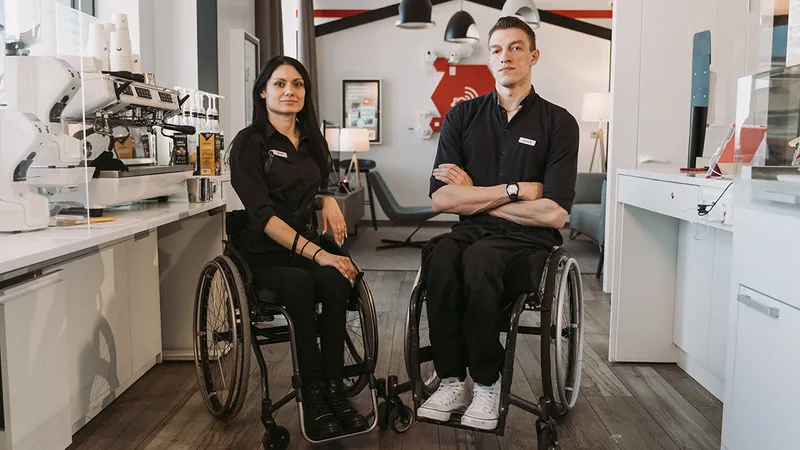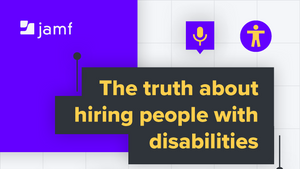Part one in a three-part series. Read part two: How to recruit disabled workers. Read part three: How to accommodate disabled workers.
Recruiting disabled staff improves company performance.
A 2018 study by Accenture in partnership with Disability:IN and the American Association of People with Disabilities (AAPD), shows that businesses that actively seek to employ people with disabilities outperform businesses that do not.
In fact, on average, businesses with a specific and targeted campaign to hire disabled people have double the net income of their peers.
In addition:
- Their revenues were 28% higher
- Profit margins were 30% higher
- They were twice as likely to have higher total shareholder returns
Those are some serious advantages for the bottom line!
What is a disability, exactly?
The United Nations defines disabled people as "those who have long-term physical, mental, intellectual or sensory impairments which in interaction with various barriers may hinder their full and effective participation in society on an equal basis with others."
What are examples of disabilities?
- Auditory
- Cognitive
- Neurological
- Physical
- Speech
- Visual
- Psychological
What sort of workers are people with disabilities?
Disabled employees show up
Many studies, including one by Western Australia's Department of Communities, Disability Services, have shown that people with disabilities take fewer days off and stay at their jobs longer than their non-disabled counterparts.
Employees with disabilities stay with organizations longer
Multiple global studies show that disabled employees have less turnover. That means that they provide continuity, have accumulated knowledge, and improve the bottom line by limiting the costs of recruiting and onboarding new employees.
Core competency in disability issues
Companies that employ disabled workers have the advantage disabled people bring when courting the disabled market.
It's not just the visibility of disabled employees that makes disabled customers more comfortable (although it sure doesn't hurt), but it's also plain-old lived experience.
If you have a large enough group of employees with disabilities in organizations, they will notice things that others don't: a check-in desk that is too high, software that is hard to navigate, procedures and workflows that can be difficult for various disabled workers.
They will also have a vocabulary for discussing disability and disabilities in ways that resonate more with customers with disabilities. They are part of a community that has frequent (and passionately argued!) discussions about language, attitudes toward disability and difficulty with disablism that most non-disabled people aren't involved in.
This helps to show your market that you understand them and have the products or services that they need.
A market worth targeting
And it’s quite a market: according to the World Health Organization (WHO) and the World Bank, 15%, or a billion people worldwide, have some sort of disability. This represents a spending power of more than $13 trillion.
That's a market bigger than China.
What is accessibility?
Accessibility is ensuring that buildings, workflows, tools and technologies are designed so that employees with disabilities can use them.
This includes accessible buildings that think beyond ramps and attempt to incorporate genuine accessibility into their office designs. A few examples include:
- Staff kitchens and bathrooms with rumble strips, accessible cabinets and equipment low enough for everyone to use
- Designated quiet and less bright workspaces
- Easily available and well-publicized abilities to offer local sign language interpreters and captions for online meetings
- Screenreaders, voice control, special fonts and distraction-free settings on devices
- Flexibility and the ability to work from home (which is good for everyone!)
What holds companies back from recruiting disabled employees?
Despite these obvious gains, few organizations actively recruit from this talent pool. Why?
The myths about hiring workers with disabilities
According to a 2021 article on hiring disabled employees from Forbes, employers leery of hiring disabled staff are falling victim to some misconceptions and stereotypes about people with disabilities. They might believe that people with disabilities:
- Can't actually work or can only perform 'unskilled' labor
- Have a higher absentee rate;
- Are not as productive as their co-workers
- Cost more to recruit, train and employ
- Reduce their co-workers’ productivity
The facts about hiring workers with disabilities
- Companies that have successful programs for recruiting and retaining disabled employees require all of them to meet the same requirements as non-disabled recruits.
- People with disabilities take fewer days off when compared with non-disabled peers.
- Statistical analysis shows that disabled people are as productive or more productive than average.
- A 2020 study on the benefits and costs of accommodation shows that most employers report no or low costs for accommodating employees with disabilities.
- Rather than reducing co-workers’ productivity, disabled employees increase overall productivity and morale.
Next: How to create an accessible workplace and hiring process
So, you're sold! You'd like to get a jump on the competition by recruiting and retaining employees with disabilities. Where do you start?
Our next blog post in this series will cover accommodations and the best tech for offering many of them (Spoiler alert! It's Apple), alternative hiring practices and more.
Part one in a three-part series. Next: How to recruit disabled workers.
Business case resource
W3c, an international organization creating and advocating for global digital accessibility standards, has an excellent business case page for further information on why hiring disabled people is good for business that you can use for presentations or just to start a conversation about reaching out to people with disabilities.
by Category:
Have market trends, Apple updates and Jamf news delivered directly to your inbox.
To learn more about how we collect, use, disclose, transfer, and store your information, please visit our Privacy Policy.




